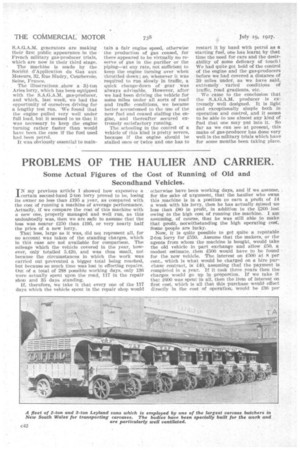THE SMALLEST FRENCH GAS-PRODUCER.
Page 63

Page 64

If you've noticed an error in this article please click here to report it so we can fix it.
A New Product, Small in Size and Light in Weight, Now Competing in the French Military Trials.
MBE S.A.G.A.M., a new wood-fuel
.gas-producer for industrial vehicles, which has just appeared in France, is really an improved version of the Also gazogene, which was described in this journal some time ago. A new company, La Societe d'Application du Gaz aux Moteurs, has been formed to take over the Also business.
The S.A.G.A.M. is unquestionably the smallest and lightest wood-burning appliance yet produced on the Continent, the weight of the entire outfit, including .pipework, being only 120 kilogs. The generator and gas purifier are remarkable for their simplicity.
The furnace is of the inverted type, with through draught from top to bottom. The air enters the furnace through jets radially dis-. posed round the upper part, and a further series of jets is arranged half-way lowri. The air intake being situated at the base, the incoming air is warmed as it passes up the passages in the walls of the generator before reaching the jets. At the bottom of the furnace are a grid and an ash box.
The latter is surrounded by an annular chamber :containing coke.
The production of ash is very small, as combustion takes place at a high temperature. Such ash as may be formed is in the nature of extremely fine dust. This falls to the bottom of the ash box, whilst the gas passes out into the coke chamber through a number of perforations. Any tars which may have remained in suspension in the gas are caught and deposited in the cake.
An arrangement is provided whereby all the air intakes can he closed simultaneously when the vehicle is at rest. This prevents the generator from smoking when the engine is not turning over.
The gas purifier is of the simplest nature. The arrangement comprises three steel cylinders. The' first of these is divided into two compartments, one being a dust box and the other a scrubber filled with steel turnings. In the second and third cylinders spiral baffles impart a rotary movement to the gas, and any particles in suspension are thrown on to the walls by centrifugal force. From the purifier, which is placed on the opposite side of the lorry to the generator, the gas is conducted back to the induction side of the engine through a condenser. Any water collecting in the condenser is drawn off by means of a special form of automatic ejector valve.
The S.A.G.A.M. appliance is usually started by running the engine on petrol for a few' minutes, but a handstarter fan is fitted for use when it is desired to start away directly on wood fuel. The usual time required from lighting up the furnace when cold to getting the engine running on gas is about five minutes.
The fuel consumption claimed for the S.A.G.A.M. gas-producer is 1. klieg per hp. hour. For a 4-ton lorry this would mean a :consumption of about 80 kilogs. of wood per 100 kilometres of running (52.13 miles). Practically any wood can be used.
The S.A.G.A.M. machine gained an excellent reputation in its original form ; this reputation should 'certainly be maintained by. the present much-simplified type. The new S.A.G.A.M. generators are making their first public appearance in the French military gas-producer trials, which are now in their third stage.
The machine is made by the SoClete d'Application du Gaz aux Moteurs, 32, Rue audry, Courbevoie, Seine, France.
The illustrations show a 31-ton Aries lorry, which has been equipped with the S'.A:G.A.M. gas-producer, and which, last week, we had the opportunity of ourselves driving for a lengthy test run. We found that the engine pulled very well under full load, but it seemed to us that it was necessary to keep the engine .turning rather faster than would have been. the case if the fuel used had been petrol.
It was obviously essential to main
tain a .fair engine speed, otherwise the production of gas ceased, for there appeared to be virtually no reserve of gas in the purifier or the piping—at any rate, not sufficient to keep the engine turning over when throttled down; so, whenever it was required to run slowly in traffic, a quick change-down of gear was always advisable. However, after we had been driving the vehicle for some miles under all sorts of road and traffic conditions, we became bettor accustomed to the use of the new fuel and ceased stalling the engine, and thereafter secured extremely satisfactory running.
The schooling in the control of a Vehicle of this kind is pretty severe, because if the engine should be stalled once or twice and one has to restart it by band with petrol as a starting fuel, one has learnt by that time the need for care and the desirability of some delicacy of touch! We had quite got hold of the control of the engine and the gas-producers before we had covered a distance of 20 miles under, as we have said, extremely varied conditions of traffic, road gradients, etc.
We came to the conclusion that the S.A.G.A.M. producer is extremely well designed. It is light and exceptionally simple both in operation and control, and it seems to be able to use almost any kind of fuel that one may put into it. So far as we can see at present, this make of gas-producer has done very well in the military trials which have for some months been taking place.












































































































